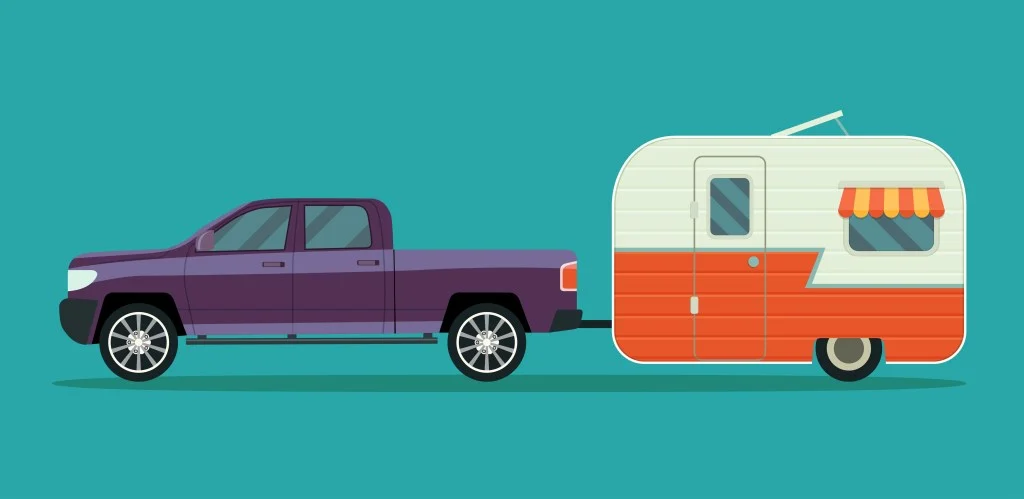Towing an RV trailer isn’t always easy. It might suddenly start to sway from side to side or hop up and down on the open road. A weight distribution hitch can help to solve these kinds of problems or even prevent a horrible accident.
Not everyone uses a weight distribution hitch, and some avid campers are unaware of the important function they serve.
Let’s read on to find out more about them. We’ll explain what they do – and what they don’t.
We’ll help you determine whether you need one to make your excursions run more safe and smooth.
What is a Weight Distribution Hitch for Camper Trailers?
A weight distribution hitch is a simple mechanical device that helps to keep your trailer steady in transit. You install it under the tongue of your trailer and it levels things out.
It accomplishes this by transferring weight from the rear of your tow vehicle to the front.
How Do They Work?
In science class you probably learned about a basic principle of physics called leverage.
This is how a weight-distribution hitch works. It uses adjustable spring bars or chains to physically move the angle of the hitch point, which changes the tension.
They redistribute the weight of the trailer basically by moving the hitch point backward, toward the rear of the trailer.
If you want to get into the geeky way it works, check out this article from How Stuff Works.

Benefits of Weight Distribution Hitches
With a more even distribution of weight, you’re going to have a smoother ride. This means better control for the driver.
With improved steering and braking abilities, it can mean less stress all around. You’ll relax a bit and your tow vehicle and trailer won’t experience as much wear and tear.
Some RVers report a major improvement in performance once they’ve installed a weight-distribution hitch. Others say the changes have been less drastic. It definitely depends on your specific situation – what you’re driving and what you’re pulling.
There are many great Weight Distribution Hitch setups available. However, this is our favorite at a fair price point.
Who Needs a Weight Distribution Hitch?
Is there a sag right there in the middle, whether your trailer meets the hitch? This means there’s too much weight on the bumper and not enough on the axles. It’s a good sign that you may need a weight-distribution hitch.
Maybe the sag, which some people call “squat” or “dive,” isn’t that noticeable. Another indicator is if your headlights shine upward instead of straight ahead.
Also, take a close look at your towing capacity and the gross weights of both your tow vehicle and your trailer. If the trailer weighs more than half of what your truck weighs, this can cause that sway we mentioned earlier. (It’s kind of like the tail wagging the dog.)
Pro Tip: Here’s our guide for finding the right size truck for your RV camper trailer.

Does a Weight Distribution Hitch Increase Towing Capacity?
A weight distribution hitch won’t increase how much you can tow. It will, however, help you get the most out of what you have.
Maybe you’ve heard the expression that says “you’re only as strong as your weakest link.” Adding a weight distribution feature means your hitch won’t be the lowest-rated component in your towing system.
Does a Weight Distribution Hitch Reduce Tongue Weight?
A weight distribution hitch doesn’t actually reduce tongue weight. In fact, it doesn’t reduce any weight at all. It just moves (or “distributes” it from one place to another).
Are They Required By Law?
Weight distributing hitches aren’t mandated by law. Some truck manufacturers, however, list them as a requirement for towing trailers over a certain weight. This is basically a way of releasing them from legal liability.
Some hitches are not designed for use with weight distribution systems. Always check the trailer hitch’s weight rating label for a weight distribution towing capacity. If there is no such capacity listed, then you shouldn’t use one.
In fact, popular RV YouTubers, Fate Unbound, recently released a video explaining why that don’t use one. You can watch it below.
Is a Weight Distribution Hitch for You?
For a successful camping outing with your RV, you have to have a certain amount of equipment. A weight distribution hitch isn’t on everyone’s list of must-have items, but perhaps it should be.
In some ways, it’s like packing a bit of peace of mind.
Discover the Best Free Camping Across the USA
To be honest with you, we hate paying for camping. There are so many free campsites in America (with complete privacy).
You should give it a try!
As a matter of fact, these free campsites are yours. Every time you pay federal taxes, you’re contributing to these lands.
Become a FREE CAMPING INSIDER and join the 100,000 campers that love to score the best site!
We’ll send you the 50 Best Free Campsites in the USA (one per state). Access the list by submitting your email below:
sometimes the sag you mention is caused simply by the hitch ball not set at proper height for the towed trailer.
I once met a couple towing a mid-weight airstream with a new Duramax Diesel 2500 truck and were planning to buy a new truck because they were experiencing white knuckle fear at the swaying with the weight hitch. Their ball height was set 2 or so inches higher than a/s recommended. Their set up did not need weight hitch at all.